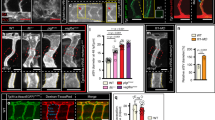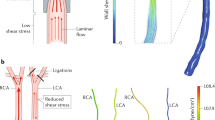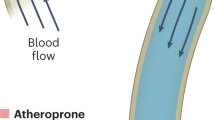Abstract
Vascular tone control is essential in blood pressure regulation, shock, ischemia-reperfusion, inflammation, vessel injury/repair, wound healing, temperature regulation, digestion, exercise physiology, and metabolism. Here we show that a well-known growth factor, FCF2, long thought to be involved in many developmental and homeostatic processes, including growth of the tissue layers of vessel walls, functions in vascular tone control. Fgf2 knockout mice are morphologically normal and display decreased vascular smooth muscle contractility, low blood pressure and thrombocytosis. Following intra-arterial mechanical injury, FGF2-deficient vessels undergo a normal hyperplastic response. These results force us to reconsider the function of FGF2 in vascular development and homeostasis in terms of vascular tone control.
This is a preview of subscription content, access via your institution
Access options
Subscribe to this journal
Receive 12 print issues and online access
$209.00 per year
only $17.42 per issue
Buy this article
- Purchase on Springer Link
- Instant access to full article PDF
Prices may be subject to local taxes which are calculated during checkout
Similar content being viewed by others
References
Kessler, D.S. & Melton, D.A. Vertebrate embryonic induction: Mesodermal and neural patterning. Science 266, 596–604 (1994).
Kimelman, D. & Kirschner, M. Synergistic induction of mesoderm by FGF and TGF-beta and the identification of an mRNA coding for FGF in the early Xenopus embryo. Cell 869–877 (1987).
Flamme, I. & Risau, W. Induction of vasculogenesis and hematopoiesis in vitro. Development 116, 435–439 (1992).
Slack, J.M. & Isaacs, H.V., Position and structure of projections formed by implants of a ventral character. Dev. Biol. 161, 313–317 (1994).
Schneider, M.D., McLellan, W.R., Black, F.M. & Parker, T.G. Growth factors, growth factor response elements, and the cardiac phenotype. Basic Res. Cardiol. 87 (Suppl. 2), 33–48 (1992).
Parker, T.G., Packer, S.E. & Schneider, M.D. Peptide growth factors can provoke “fetal” contractile protein gene expression in rat cardiac myocytes. J. Clin. Invest 85, 507–514 (1990).
Folkman, J. & Klagsbrun, M Vascular physiology: A family of angiogenic peptides. Nature 329, 671–672 (1987).
Doetschman, T., Shull, M., Kier, A. & Coffin, J.D. Embryonic stem cell model systems for vascular morphogenesis and cardiac disorders. Hypertension 22, 618–629 (1993).
Weiss, R.H. & Maduri, M. The mitogenic effect of thrombin in vascular smooth muscle cells is largely due to basic fibroblast growth factor. J. Biol Chem. 268, 5724–5727(1993).
Ali, S., Davis, M.G., Becker, M.W. & Dorn, G.W.2. Thromboxane A2 stimulates vascular smooth muscle hypertrophy by up-regulating the synthesis and release of endogenous basic fibroblast growth factor. J. Biol. Chem. 268, 17397–17403 (1993).
Itoh, H., Mukoyama, M., Pratt, R.E., Gibbons, G.H. & Dzau, V.J. Multiple autocrine growth factors modulate vascular smooth muscle cell growth response to angiotensin II. J. Clin. Invest 91, 2268–2274 (1993).
Davis, M.G., et al. Intracrine and autocrine effects of basic fibroblast growth factor in vascular smooth muscle cells. J. Mol. Cell Cardiol. 29, 1061–1072 (1997).
Hebert, J.M., Basilico, C., Goldfarb, M., Haub, O. & Martin, G.R., Isolation of cDNAs encoding four mouse FGF family members and characterization of their expression patterns during embryogenesis. Dev. Biol. 138, 454–463 (1990).
Yanagisawa Miwa, A., et al. Salvage of infarcted myocardium by angiogenic action of basic fibroblast growth factor. Science 257, 1401–1403 (1992).
Lindner, V. & Reidy, M.A. Proliferation of smooth muscle cells after vascular injury is inhibited by an antibody against basic fibroblast growth factor. Proc. Natl. Acad. Sci. USA 88, 3739–3743 (1991).
Tsuboi, R., Shi, C.M., Rifkin, D.B. & Ogawa, H.A. wound healing model using healing-impaired diabetic mice. J. Dermatol. 19, 673–675 (1992).
MacMillan, V., et al. Mice expressing a bovine basic fibroblast growth factor trans-gene in the brain show increased resistance to hypoxemic- ischemic cerebral damage. Stroke 24, 1735–1739 (1993).
Coffin, J.D., et al. Abnormal bone growth and selective translational regulation in basic fibroblast growth factor (FGF-2) transgenic mice. Mol. Biol. Cell 6, 1861–1873(1995).
Thompson, S., Clarke, A.R., Pow, A.M., Hooper, M.L. & Melton, D.W. Germ line transmission and expression of a corrected HPRT gene produced by gene targeting in embryonic stem cells. Cell 56, 313–321 (1989).
Baird, A., Schubert, D., Ling, N. & Guillemin, R. Receptor- and heparin-binding domains of basic fibroblast growth factor. Proc. Natl. Acad. Sci. USA 85, 2324–2328 (1988).
Arakawa, T., et al. The importance of Arg40 and 45 in the mitogenic activity and structural stability of basic fibroblast growth factor: Effects of acidic amino acid substitutions. J. Protein Chem. 14, 263–274 (1995).
Faham, S., Hileman, R.E., Fromm, J.R., Linhardt, R.J. & Rees, D.C. Heparin structure and interactions with basic fibroblast growth factor. Science 271, 1116–1120 (1996).
Sugi, Y., Sasse, J. . & Lough, J. Inhibition of precardiac mesoderm cell proliferation by antisense oligodeoxynucleotide complementary to fibroblast growth factor-2 (FGF-2). Dev. Biol. 157, 28–37 (1993).
Merle, P.L., Feige, J.J. & Verdetti, J. Basic fibroblast growth factor activates calcium channels in neonatal rat cardiomyocytes. J. Biol. Chem. 270, 17361–17367 (1995).
Lorenz, J.N. & Robbins, J. Measurement of intraventricular pressure and cardiac performance in the intact closed-chest anesthetized mouse. Am. J. Physiol. 272, H1137–H1146 (1997).
Grupp, I.L., Subramaniam, A., Hewett, T.E., Robbins, J. & Grupp, G. Comparison of normal, hypodynamic, and hyperdynamic mouse hearts using isolated work-performing heart preparations. Am. J. Physiol. 265, H1401–H1410 (1993).
Huang, P.L., et al. Hypertension in mice lacking the gene for endothelial nitric oxide synthase. Nature 377, 239–242 (1995).
Cristiani, C., Volpi, D., Landonio, A., & Bertolero, F. Endothelin-1 -selective binding sites are downregulated by transforming growth factor-beta and upregulated by basic fibroblast growth factor in a vascular smooth muscle-derived cell line. J. Cardiovasc. Pharmacol. 23, 988–994 (1994).
Sutter, M.C. & Ljung, B., Contactility, muscle mass and agonist sensitivity of isolated portal veins from normo- and hypertensive rats. Acta Physiol. Scand. 99, 484–495 (1977).
Schwartz, S.M. & Liaw, L. Growth control and morphogenesis in the development and pathology of arteries. J. Cardiovasc. Pharmacol. 21 (Suppl. 1), S31–S49 (1993).
Carmeliet, P., Moons, L., Ploplis, V., Plow, E. & Collen, D. Impaired arterial neointima formation in mice with disruption of the plasminogen gene. J. Clin. Invest 99, 200–208 (1997).
Currier, J.W. & Faxon, D.P. Restenosis after percutaneous transluminal coronary angioplasty: Have we been aiming at the wrong target? J. Am. Coll. Cardiol. 25, 516–520(1995).
Schwartz, S.M., Campbell, G.R. & Campbell, J.H. Replication of smooth muscle cells in vascular disease. Circ. Res. 58, 427–444 (1986).
Campbell, G.R. & Campbell, J.H. The phenotypes of smooth muscle expressed in human atheroma. Ann. N.Y. Acad. Sci. 598, 143–58, 143-158 (1990).
Aikawa, M., et al. Human smooth muscle myosin heavy chain isoforms as molecular markers for vascular development and atherosclerosis. Circ. Res. 73, 1000–1012 (1993).
Aikawa, M., et al. Phenotypic modulation of smooth muscle cells during progression of human atherosclerosis as determined by altered expression of myosin heavy chain isoforms. Ann. N.Y. Acad. Sci. 748, 578–85, 578–585 (1995).
Allouche, M. Basic fibroblast growth factor and hematopoiesis. Leukemia 9 937–942 (1995).
Muenke, M., et al. A common mutation in the fibroblast growth factor receptor 1 gene in Pfeiffer syndrome. Nature Genet 8, 269–274 (1994).
Rutland, P., et al. Identical mutations in the FGFR2 gene cause both Pfeiffer and Crouzon syndrome phenotypes. Nature Genet 9 173–176(1995).
Jabs, E.W., et al. Jackson-Weiss and Crouzon syndromes are allelic with mutations in fibroblast growth factor receptor 2. Nature Genet 8, 275–279 (1994).
Rousseau, F., et al. Mutations in the gene encoding fibroblast growth factor receptor- 3 in achondroplasia. Nature 371, 252–254 (1994).
Colvin, J.S., Bohne, B.A., Harding, G.W., McEwen, D.G. & Ornitz, D.M. Skeletal overgrowth and deafness in mice lacking fibroblast growth factor receptor 3. Nature Genet 12, 390–397 (1996).
Burstein, S.A., Adamson, J.W., Thorning, D. & Harker, L.A. Characteristics of murine megakaryocytic colonies in vitro. Blood 54, 169–179 (1979).
Lalli, J., Harrer, J.M., Luo, W., Kranias, E.G., & Paul, R.J. Targeted ablation of the phospholamban gene is associated with a marked decrease in sensitivity in aortic smooth muscle. Circ. Res. 80, 506–513 (1997).
Author information
Authors and Affiliations
Rights and permissions
About this article
Cite this article
Zhou, M., Sutliff, R., Paul, R. et al. Fibroblast growth factor 2 control of vascular tone. Nat Med 4, 201–207 (1998). https://doi.org/10.1038/nm0298-201
Received:
Accepted:
Issue Date:
DOI: https://doi.org/10.1038/nm0298-201
This article is cited by
-
Functional cargos of exosomes derived from Flk-1+ vascular progenitors enable neurulation and ameliorate embryonic anomalies in diabetic pregnancy
Communications Biology (2022)
-
Periostin gene expression in neu-positive breast cancer cells is regulated by a FGFR signaling cross talk with TGFβ/PI3K/AKT pathways
Breast Cancer Research (2021)
-
Gait disturbances and muscle dysfunction in fibroblast growth factor 2 knockout mice
Scientific Reports (2021)
-
Association of circulating fibroblast growth factor-2 with progression of HIV-chronic kidney diseases in children
Pediatric Nephrology (2021)
-
Mechanisms of bone development and repair
Nature Reviews Molecular Cell Biology (2020)



